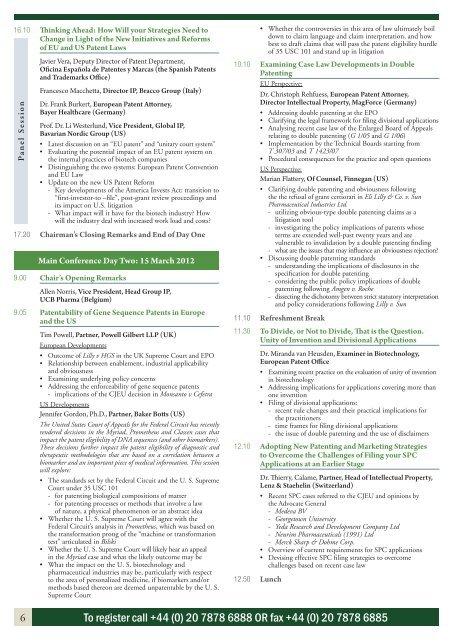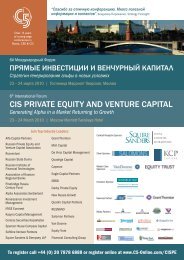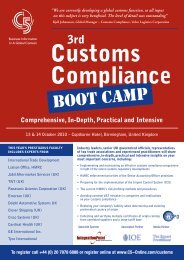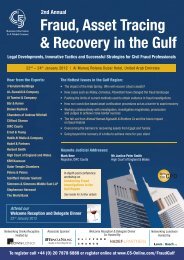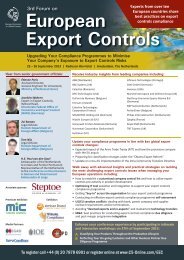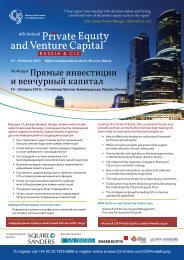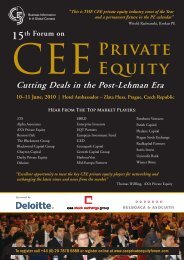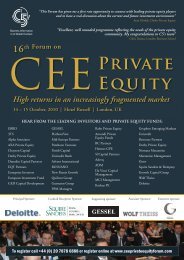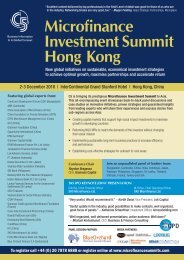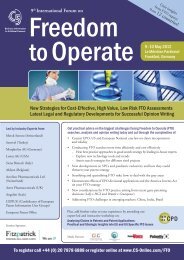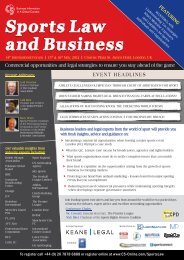The US Patent Reform for Life Science Companies - C5
The US Patent Reform for Life Science Companies - C5
The US Patent Reform for Life Science Companies - C5
- No tags were found...
Create successful ePaper yourself
Turn your PDF publications into a flip-book with our unique Google optimized e-Paper software.
16.10 Thinking Ahead: How Will your Strategies Need to<br />
Change in Light of the New Initiatives and <strong>Re<strong>for</strong>m</strong>s<br />
of EU and <strong>US</strong> <strong>Patent</strong> Laws<br />
6Panel Session<br />
Javier Vera, Deputy Director of <strong>Patent</strong> Department,<br />
Oficina Española de <strong>Patent</strong>es y Marcas (the Spanish <strong>Patent</strong>s<br />
and Trademarks Office)<br />
Francesco Macchetta, Director IP, Bracco Group (Italy)<br />
Dr. Frank Burkert, European <strong>Patent</strong> Attorney,<br />
Bayer Healthcare (Germany)<br />
Prof. Dr. Li Westerlund, Vice President, Global IP,<br />
Bavarian Nordic Group (<strong>US</strong>)<br />
• Latest discussion on an “EU patent” and “unitary court system”<br />
• Evaluating the potential impact of an EU patent system on<br />
the internal practices of biotech companies<br />
• Distinguishing the two systems: European <strong>Patent</strong> Convention<br />
and EU Law<br />
• Update on the new <strong>US</strong> <strong>Patent</strong> <strong>Re<strong>for</strong>m</strong><br />
- Key developments of the America Invests Act: transition to<br />
“first-investor-to –file”, post-grant review proceedings and<br />
its impact on U.S. litigation<br />
- What impact will it have <strong>for</strong> the biotech industry How<br />
will the industry deal with increased work load and costs<br />
17.20 Chairman’s Closing Remarks and End of Day One<br />
Main Conference Day Two: 15 March 2012<br />
9.00 Chair’s Opening Remarks<br />
Allen Norris, Vice President, Head Group IP,<br />
UCB Pharma (Belgium)<br />
9.05 <strong>Patent</strong>ability of Gene Sequence <strong>Patent</strong>s in Europe<br />
and the <strong>US</strong><br />
Tim Powell, Partner, Powell Gilbert LLP (UK)<br />
European Developments<br />
• Outcome of Lilly v HGS in the UK Supreme Court and EPO<br />
• Relationship between enablement, industrial applicability<br />
and obviousness<br />
• Examining underlying policy concerns<br />
• Addressing the en<strong>for</strong>ceability of gene sequence patents<br />
- implications of the CJEU decision in Monsanto v Cefetra<br />
<strong>US</strong> Developments<br />
Jennifer Gordon, Ph.D., Partner, Baker Botts (<strong>US</strong>)<br />
<strong>The</strong> United States Court of Appeals <strong>for</strong> the Federal Circuit has recently<br />
rendered decisions in the Myriad, Prometheus and Classen cases that<br />
impact the patent eligibility of DNA sequences (and other biomarkers).<br />
<strong>The</strong>se decisions further impact the patent eligibility of diagnostic and<br />
therapeutic methodologies that are based on a correlation between a<br />
biomarker and an important piece of medical in<strong>for</strong>mation. This session<br />
will explore:<br />
• <strong>The</strong> standards set by the Federal Circuit and the U. S. Supreme<br />
Court under 35 <strong>US</strong>C 101<br />
- <strong>for</strong> patenting biological compositions of matter<br />
- <strong>for</strong> patenting processes or methods that involve a law<br />
of nature, a physical phenomenon or an abstract idea<br />
• Whether the U. S. Supreme Court will agree with the<br />
Federal Circuit’s analysis in Prometheus, which was based on<br />
the trans<strong>for</strong>mation prong of the “machine or trans<strong>for</strong>mation<br />
test” articulated in Bilski<br />
• Whether the U. S. Supreme Court will likely hear an appeal<br />
in the Myriad case and what the likely outcome may be<br />
• What the impact on the U. S. biotechnology and<br />
pharmaceutical industries may be, particularly with respect<br />
to the area of personalized medicine, if biomarkers and/or<br />
methods based thereon are deemed unpatentable by the U. S.<br />
Supreme Court<br />
• Whether the controversies in this area of law ultimately boil<br />
down to claim language and claim interpretation, and how<br />
best to draft claims that will pass the patent eligibility hurdle<br />
of 35 <strong>US</strong>C 101 and stand up in litigation<br />
10.10 Examining Case Law Developments in Double<br />
<strong>Patent</strong>ing<br />
EU Perspective:<br />
Dr. Christoph Rehfuess, European <strong>Patent</strong> Attorney,<br />
Director Intellectual Property, MagForce (Germany)<br />
• Addressing double patenting at the EPO<br />
• Clarifying the legal framework <strong>for</strong> filing divisional applications<br />
• Analysing recent case law of the Enlarged Board of Appeals<br />
relating to double patenting (G 1/05 and G 1/06)<br />
• Implementation by the Technical Boards starting from<br />
T 307/03 and T 1423/07<br />
• Procedural consequences <strong>for</strong> the practice and open questions<br />
<strong>US</strong> Perspective:<br />
Marian Flattery, Of Counsel, Finnegan (<strong>US</strong>)<br />
• Clarifying double patenting and obviousness following<br />
the the refusal of grant certiorari in Eli Lilly & Co. v. Sun<br />
Pharmaceutical Industries Ltd.<br />
- utilizing obvious-type double patenting claims as a<br />
litigation tool<br />
- investigating the policy implications of patents whose<br />
terms are extended well-past twenty years and are<br />
vulnerable to invalidation by a double patenting finding<br />
- what are the issues that may influence an obviousness rejection<br />
• Discussing double patenting standards<br />
- understanding the implications of disclosures in the<br />
specification <strong>for</strong> double patenting<br />
- considering the public policy implications of double<br />
patenting following Amgen v. Roche<br />
- dissecting the dichotomy between strict statutory interpretation<br />
and policy considerations following Lilly v. Sun<br />
11.10 Refreshment Break<br />
11.30 To Divide, or Not to Divide, That is the Question.<br />
Unity of Invention and Divisional Applications<br />
Dr. Miranda van Heusden, Examiner in Biotechnology,<br />
European <strong>Patent</strong> Office<br />
• Examining recent practice on the evaluation of unity of invention<br />
in biotechnology<br />
• Addressing implications <strong>for</strong> applications covering more than<br />
one invention<br />
• Filing of divisional applications:<br />
- recent rule changes and their practical implications <strong>for</strong><br />
the practitioners<br />
- time frames <strong>for</strong> filing divisional applications<br />
- the issue of double patenting and the use of disclaimers<br />
12.10 Adopting New <strong>Patent</strong>ing and Marketing Strategies<br />
to Overcome the Challenges of Filing your SPC<br />
Applications at an Earlier Stage<br />
Dr. Thierry, Calame, Partner, Head of Intellectual Property,<br />
Lenz & Staehelin (Switzerland)<br />
• Recent SPC cases referred to the CJEU and opinions by<br />
the Advocate General<br />
- Medeva BV<br />
- Georgetown University<br />
- Yeda Research and Development Company Ltd<br />
- Neurim Pharmaceuticals (1991) Ltd<br />
- Merck Sharp & Dohme Corp.<br />
• Overview of current requirements <strong>for</strong> SPC applications<br />
• Devising effective SPC filing strategies to overcome<br />
challenges based on recent case law<br />
12.50 Lunch<br />
To register call +44 (0) 20 7878 6888 OR fax +44 (0) 20 7878 6885


